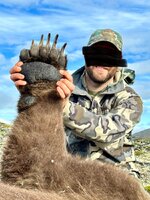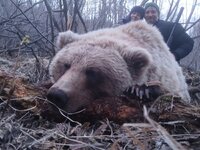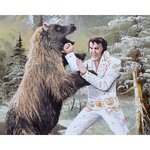Law enforcement already has AR15s and 12 Guage so it's probably a logical choice. Guys in the bear safety world often use shotguns. They work, they can quickly chamber, and they can launch non lethals. But no one I know hunts with them.
Navigation
Install the app
How to install the app on iOS
Follow along with the video below to see how to install our site as a web app on your home screen.
Note: This feature may not be available in some browsers.
More options
Style variation
You are using an out of date browser. It may not display this or other websites correctly.
You should upgrade or use an alternative browser.
You should upgrade or use an alternative browser.
What does it take to kill a grizzly?
- Thread starter Luke S
- Start date
Dust Rider
WKR
Axlrod
WKR
Well to answer your question, I will show a movie. A movie of Fred Bear shooting griz with a recurve. He shoots this bear as it was feeding on a moose carcass. He also had shot at and missed this same bear earlier in the day. After shooting the bear, it spins in a circle, takes a couple steps and falls stone dead. So from this, what it takes to kill a grizzly (with a recurve) is great big freaking balls! 
Movie quality is poor, and I think most of the sound effects were added in a studio.
The kill shot is around 11:40.
Movie quality is poor, and I think most of the sound effects were added in a studio.
The kill shot is around 11:40.
- Banned
- #24
PredatorSlayer
WKR
- Joined
- Jul 20, 2019
- Messages
- 3,034
I would take a reliable AR 308 with 168gr ELDMs.
I doubt they are using a 12 Guage with slugs for precision shooting. More likely close quarters work. I bet they don't use those on their personal hunting trips.
Sent from my SM-S901U using Tapatalk
I bet they don’t either. Because a hunted bear is really not an issue. A wounded bear is. The best shot on a wounded bear, a stopping shot, is through the hips.
TaperPin
WKR
- Joined
- Jul 12, 2023
- Messages
- 6,317
The fellow I met who was a federal wildlife employee who takes care of wounded and problem bears in Alaska used a 375 H&H until upgrading to 416 Rem. The Safeway grocery store on Kodiak has 375 H&H, 416, and 458 on the shelf. Lol
Trees91
WKR
I killed this one with @luke moffat 's old 375 h&h Talkeenta. I've also killed them with 300 win mag and 375 Ruger. The Talkeenta is my favorite and will head north with me again this fall.


Dbevans
WKR
- Joined
- Oct 18, 2021
- Messages
- 329
There has been such a focus on bears in the .223 thread I thought I’d start a thread on what I think it takes to actually kill a bear. I am not a guide, other people have killed more bears then me. But I have killed lots of black bears, I mentored other hunters to their first bear, and I’ve killed two grizzlies solo. I’ve done this with everything from a .375 Ruger down to a .308 shooting low recoil youth loads that put it more in the category of a 6.5 Grendal.
First, I don’t care if someone brain shot a bear with a .22 rifle. That is a cool story but I don’t know anyone who wants to limit themselves to brain shots only while bear hunting. Here is what needs to happen to kill a bear reliably in a hunting situation that could turn into a self defense situation if a bear charges after being hit.
On a broadside shot a bullet needs to punch through the ribs and the lungs. If it exits that is nice but not totally necessary. Form has covered this idea in the Shoot2Hunt podcast. Its not unusual for a bullet to stop just under the skin because the skin acts like a trampoline. In other words, if your bullet stops just under the skin after going through 20 inches of one bear, it doesn’t mean the bullet will stop after going through 20 inches of a bigger bear. On a bigger bear it might go through more then 20 inches of vitals and stop under the skin.
On a quartering too shot, the bullet needs to go through a bit more muscle and maybe, a shoulder bone. Scapulas are not big deal. A brown bear’s arm bone is not huge like a bovine. If my memory is correct my 8 foot grizzly had about a 1.5 inch bone, maybe less. It was definitely less then a moose shoulder bone and probably equal to an elk, maybe less (I have never killed an elk but I have looked at elk skeletons). My only interest in breaking bones is that in some situations a bullet needs to go through a shoulder to get to the vitals. The idea of “breaking a bear down” with a shoulder hit is silly. I’ve seen bears run away very fast with a smashed shoulder.
In a head on charge situation, you want a bullet that is able to punch through a bear’s skill to hit the brain. Again, a bear’s skull is not bullet proof. If a bullet can’t make it through a bear’s skull its probably not a bullet you should be hunting with anyway. Maybe a huge grizzly has a thicker skull but the skulls I’ve seen wouldn’t stop a normal hunting bullet that could also go through a rib cage or shoulder bone of a bear or elk.
I have seen various theories on the internet about “hydrostatic shock” with the idea being if I hit an animal with a big caliber bullet or a fast enough bullet it will drop instantly. Form has quoted academic articles arguing that hydrostatic shock is a myth. I can’t speak to that but I have never seen a bear drop instantly with anything other than a brain shot. All we know for sure is that animals die when they bleed enough or their CNS is disrupted. So unless we are taking brain shots we want to make a big hole in a bear’s chest, and then get ready to shoot it again if necessary.
So to summarize, a brown bear killing bullet is nothing magical. It needs to punch through roughly the same amount of meat and bone as a bullet for elk or moose. After that, it needs to create a wide enough wound channel to quickly deprive the brain of oxygen.
Now the part we can argue about...
If I recall, it has been agreed by people like Form that a .223 does make a smaller hole than a .308 or 6.5 with an equivalent bullet. The argument in the .223 thread is that the bigger wounds of the bigger calibers don’t translate to quicker killing in deer or elk. I would argue that if a .223 can reliably kill elk it could reliably kill brown bears. But “reliably killing” might still involve animals running a bit after being hit. Not a big deal with an elk. With bears it can lead people to freak out a bit.
In summary, I think the one area where the jury is still out is whether a bear might die a bit faster if hit with a bigger bullet that creates a bigger hole draining more blood faster. In other words, maybe a .308 would be worth a bit more blast and recoil compared to a .223. I don’t know. I haven’t had the chance to try a .223 or a .308 with really destructive bullets.


Hornady black 223 fmj one shot dropped in its tracks
Sent from my iPhone using Tapatalk
Dbevans
WKR
- Joined
- Oct 18, 2021
- Messages
- 329
Nice any idea of the wound channel?
It penciled through, the front shoulder broke the shoulder, hit the lung/guts and out the other side. Did not look bad at all
Sent from my iPhone using Tapatalk
Interesting. I'm not surprised a fmj could do that. But I would have assumed it would have led to a narrow wound channel and a slow kill. Sounds like it worked well. Any other things happening? I've seen shattered bone fragments make wounds bigger and I know fmj bullets can upset sometimes.It penciled through, the front shoulder broke the shoulder, hit the lung/guts and out the other side. Did not look bad at all
Sent from my iPhone using Tapatalk
william schmaltz
WKR
What does it take to kill one? Not much I reckon. How far blindly through the alders you’re willing to track one should weight heavily into the choice. My first was double lunged at over 300 yds with a 375 Ruger. I have a vivid image of watching that bullet smack and the shockwave visibly radiate out on his fur. He sprinted 200 yards to cover, hid and waited for me, and eventually died. I brought a 223 with 77 TMKs on a grizz hunt last month. The reason was that it was an extremely controlled environment. Barren ground, no vegetation, no where to run, and nowhere to hide. And we had snow machines and each had 30 rounds at the ready. I would not make the same choice if I were headed to the Chugach this weekend.
My neighbor still has his father around who invented the .50 Alaskan and has watched dozens upon dozens of large brown bears die dozens of different ways. He invented the 50 after a couple close calls made him decide the 450 Alaskan he previously invented wasn’t enough. When people like him start talking bears, calibers, and wounded bear stories; I tend to weigh their insight about 99% relevant compared to the 1% relevance of people who have never seen a big bear die but have a calculator.
My neighbor still has his father around who invented the .50 Alaskan and has watched dozens upon dozens of large brown bears die dozens of different ways. He invented the 50 after a couple close calls made him decide the 450 Alaskan he previously invented wasn’t enough. When people like him start talking bears, calibers, and wounded bear stories; I tend to weigh their insight about 99% relevant compared to the 1% relevance of people who have never seen a big bear die but have a calculator.
What bullet and rifle did you use for that 300 yard grizzly shot William? At that point it would be slowing down a lot. Probably not a lot more than what a 38-55 or .375 Winchester does at the muzzle. So effective but I bet that bear would have died a bit faster if you'd been 50 yards away.
I think Mr shmaltz summed it up well. Phil shoemaker (master guide for brown bear) used to use a 30-06 but switched to a 458 win mag. I believe the 223 could work fine in many instances. In the book Alaskas wolf man, Frank once used a 220 swift on a sow grizzly and had to shoot it 11 times while dodging the bear. He usually used a 30-06 for grizzlies. To each their own
Last edited:
Esteban
Lil-Rokslider
- Joined
- Oct 8, 2022
- Messages
- 117
But should you question any argument that starts with "scholars maintain"?...I don't think that would be wiseNo offense intended, but I think it is wise to question any argument that starts with “conventional wisdom says…”
Without citations and data, both are the same, meaningless word salad. But any undergraduate ‘ology prof worth their salt would ding the grade on a term paper for including “Scholars maintain…” without citing the student work. In contrast, people reference conventional wisdom all the time. And others who often have no direct experience on the topic or the author of the statement regularly defend them as an appeal to authority. And that’s what the internet was created for, hearsay, horseshit, and catfishing with a sprinkling of reliable information just to keep people guessing.But should you question any argument that starts with "scholars maintain"?...I don't think that would be wise
Esteban
Lil-Rokslider
- Joined
- Oct 8, 2022
- Messages
- 117
Scholars maintain that this response is correct. Well done grasshopperWithout citations and data, both are the same, meaningless word salad. But any undergraduate ‘ology prof worth their salt would ding the grade on a term paper for including “Scholars maintain…” without citing the student work. In contrast, people reference conventional wisdom all the time. And others who often have no direct experience on the topic or the author of the statement regularly defend them as an appeal to authority. And that’s what the internet was created for, hearsay, horseshit, and catfishing with a sprinkling of reliable information just to keep people guessing.
Dbevans
WKR
- Joined
- Oct 18, 2021
- Messages
- 329

6.5 cm dropped in his tracks. 8’8 brown

bear and a boone and crockett skull

Sent from my iPhone using Tapatalk
Well I was hoping to handload some 223 TMKs but I've had a lot of work and family obligations. So when I saw a 6 foot grizzly near our cabin I used my 308 Ruger Scout Rifle with 168 gr ELDM factory ammo. First shot wad through the chest big entrance and exit wounds. Possibly bigger then my .375 did with Partitions. Definitely similar to my old 358 Winchester. One lung was hit as well as the heart. A follow up from behind angled through the stomach and lodged in the heart. Only a peice of jacket was left at that point. Overall happy with it. Glad Rokslide forums gave me confidence to try something new.


Similar threads
Featured Video
Latest Articles
- TT#64 Josh Boyd Elk Hunting Strategies for Every Season
- Aaron Davidson of Gunwerks
- Spring Black Bears with Joe Kondelis
- BIG Buck Stories with the Dirty Giants Podcast
- TT#62 Brian Barney Hunting Bulls without Calling
- Hoyt Alpha AX-2 SD Review
- Kuiu Kenai vs Outdoor Vitals Vario Hooded Jacket Review
- Hoyt RX-9 Ultra Review
- Hunting Vampire Bucks & Building an Optics Kit
- Darton Sequel ST2 35 Review

